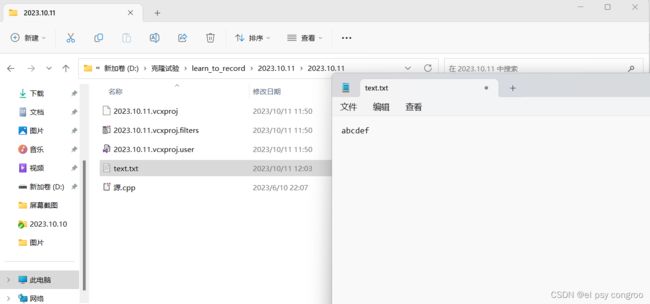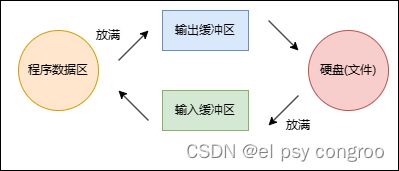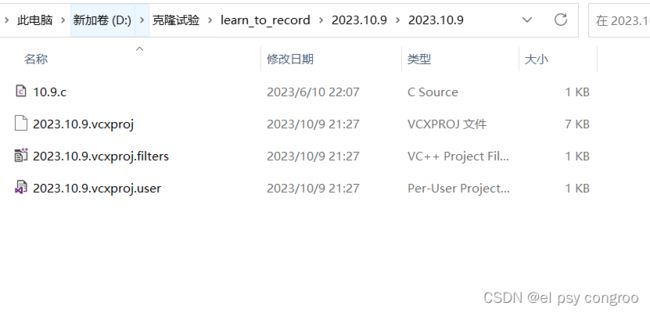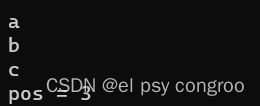C语言文件操作
文章目录
- 为什么使用文件
- 什么是文件
-
- 程序文件
- 数据文件
- 文件的打开和关闭
-
- 文件指针
- 打开和关闭
- 文件的顺序读写
-
- 顺序读写函数介绍
-
- 流
- fputc
- fgetc
- fputs
- fgets
- fprintf
- fscanf
- fwrite
- fread
- 对比一组函数:
-
- sscanf与sprintf
- 文件的随机读写
-
- fseek(需要知道文件内容)
- ftell
- rewind
- 文本文件和二进制文件
- 文件读取结束的判定
-
- 常常被错误使用的feof
- 文件缓冲区
为什么使用文件
使用文件我们可以将数据直接存放在电脑的硬盘上,做到数据的持久化
什么是文件
在程序设计中,我们一般谈的文件有两种:程序文件和数据文件(从文件功能的角度来分类)
程序文件
包括源程序文件(后缀为.c),目标文件(Windows环境后缀为.obj),可执行文件(Windows环境后缀为.exe)
数据文件
文件的内容不一定是程序,而是程序运行时读写的数据,比如程序运行需要从中读取数据的文件,或者输出内容的文件
本文讨论的是数据文件
文件的打开和关闭
文件指针
缓冲文件系统中,关键的概念是"文件类型指针",简称"文件指针"
每个被使用的文件都在内存中开辟了一个相应的文件信息区,用来存放文件的相关信息(如文件的名字,文件的状态及文件当前的位置等).这些信息是保存在一个结构体变量中的.该结构体类型是由系统声明的,取名FILE
每当打开一个文件,系统会根据文件的情况自动创建一个FILE结构的变量,并填充其中的信息,使用者不必关心细节.
一般都是通过一个FILE的指针来维护这个FILE结构的变量,这样使用起来更方便.
打开和关闭
文件在读写之前应先打开文件,在使用结束之后应该关闭文件.
在编写程序的时候,在打开文件的同时,都会返回一个FILE*类型的指针指向该文件,相当于建立了指针和文件的关系
ANSIC规定使用fopen函数来打开文件,fclose来关闭文件
//打开文件
FILE* fopen(const char* filename, const char* mode);
//关闭文件
int fclose(FILE* stream);
fopen第二个参数是打开方式
| 打开方式 | 含义 | 如果指定文件不存在 |
|---|---|---|
| “r”(只读) | 为了输入数据,打开一个已经存在的文本文件 | 出错 |
| “w”(只写) | 为了输出数据,打开一个文本文件,如果文件存在, 每次打开文件时,会清空原有内容 | 建立一个新的文件 |
| “a”(追加) | 向文本文件尾添加数据 | 建立一个新的文件 |
| “rb”(只读) | 为了输入数据,打开一个二进制文件 | 出错 |
| “wb”(只写) | 为了输出数据,打开一个二进制文件 | 建立一个新的文件 |
| “ab”(追加) | 向一个二进制文件尾添加数据 | 建立一个新的文件 |
| “r+”(读写) | 为了读与写,打开一个文本文件,如果文件存在,每次打开文件时, 从文件起始位置开始读写,写的时候会覆盖原有内容,未覆盖部分保留 | 出错 |
| “w+”(读写) | 为了读与写,打开一个文本文件,如果文件存在, 每次打开文件时,会清空原有内容 | 建立一个新的文件 |
| “a+”(读写) | 打开一个文件,在文件尾进行读写 | 建立一个新的文件 |
| “rb+”(读写) | 为了读与写打开一个二进制文件 | 出错 |
| “wb+”(读写) | 为了读与写,新建一个新的二进制文件 | 建立一个新的文件 |
| “ab+”(读写) | 打开一个二进制文件,在文件尾进行读和写 | 建立一个新的文件 |
fopen第一个参数是文件路径
1.相对路径
- 只有文件名表示当前目录下
#include- . 表示当前路径
- . . 表示上一级路径
将文件放在上一级目录
第一个参数就可以改成
"..\\test.txt"
或者是
./../test.txt
意思是当前目录的上级目录的test.txt
\\和/是一样的,只是\不要让它转义
文件的顺序读写
顺序读写函数介绍
| 功能 | 函数名 | 适用于 |
|---|---|---|
| 字符输入函数 | fgetc | 所有输入流 |
| 字符输出函数 | fputc | 所有输出流 |
| 文本行输入函数 | fgets | 所有输入流 |
| 文本行输出函数 | fputs | 所有输出流 |
| 格式化输入函数 | fscanf | 所有输入流 |
| 格式化输出函数 | fprintf | 所有输出流 |
| 二进制输入 | fread | 文件 |
| 二进制输出 | fwrite | 文件 |
流
从数据到外部设备经过流

所以我们写文件的时候要打开文件,关闭文件
所有输入流包括:文件流和标准输入流(stdin)
所有输出流包括:文件流和标准输出流(stdout)
scanf从键盘上读取数据
printf向屏幕打印数据
直接就操作了不经过流是因为:
C语言程序只要运行起来,默认打开三个流:
- 标准输入流 - stdin
- 标准输出流 - stdout
- 标准错误流 - stderr
fputc
将字符写入流
int fputc ( int character, FILE * stream );
代码示例:
#includefgetc
从流中获取字符
int fgetc ( FILE * stream );
代码示例:
读取上面用fputc写的文件
#includefputs
将字符串写入流
int fputs ( const char * str, FILE * stream );
代码示范:
#include#includefgets
从流中获取字符串
char * fgets ( char * str, int num, FILE * stream );
代码示范:
读取上面
- 如果一行的字符数小于num-1,那就只读取那一行的全部内容,第二行不会读取
#include- 如果一行的字符数大于等于num-1,那就读取num-1个字符,之后调用再读取后面剩下的(如果有\n会包括\n),之后再调用轮到下一行
#includefprintf
将格式化数据写入流
int fprintf ( FILE * stream, const char * format, ... );
代码示范:
#includefscanf
从流中读取格式化数据
int fscanf ( FILE * stream, const char * format, ... );
代码示范:
读取前面fprintf写入的数据
#includefwrite
#includefread
#include对比一组函数:
scanf/fscanf/sscanf
printf/fprintf/sprintf
- scanf 是格式化的输入函数,针对标准输入流(键盘)
- printf 是格式化的输出函数,针对标准输出流(屏幕)
- fscanf 针对所有输入流(文件流,标准输入流)的格式化输入函数
- fprintf 针对所有输出流(文件流,标准输出流)的格式化输出函数
- sscanf 将字符串转换成格式化数据
- sprintf 将格式化数据转换成字符串
sscanf与sprintf
从字符串中读取格式化数据

将格式化数据写入字符串

代码示例:
#include文件的随机读写
fseek(需要知道文件内容)
根据位置和偏移量来改变位置指针
int fseek ( FILE * stream, long int offset, int origin );
代码示例:
在当前目录下新建text.txt文件,写入abcdef

#includefseek(pf, -3, SEEK_CUR);
可以改成
fseek(pf, 0, SEEK_SET);
效果是一样的
ftell
返回位置指针相对于起始位置的偏移量
long int ftell ( FILE * stream );
代码示例:
#includerewind
让位置指针的位置回到文件的起始位置
void rewind ( FILE * stream );
代码示例:
#include文本文件和二进制文件
根据数据的组织形式,数据文件被称为文本文件或者二进制文件.
- 数据在内存中以二进制的形式存储,如果不加转换的输出到外存,就是二进制文件
- 如果要求在外存上以ascll码的形式存储,则需要在存储前转换.以ascll字符的形式存储的文件就是文本文件.
一个数据在内存中怎么存储的呢?
字符一律以ascll形式存储,数值型数据既可以用ascll形式存储,也可以用二进制形式存储.
如整数10000,如果以ascll码的形式输出到磁盘,则磁盘中占用5个字节(每个字符一个字节),而二进制形式输出,则在磁盘上只占4个字节(vs2013测试)

二进制的00110001是十进制的49,正好对应ascll码表的1
文件读取结束的判定
常常被错误使用的feof
牢记:在文件读取过程中,不能用feof函数的返回值直接来判断文件是否结束
feof的作用是:当文件读取结束的时候,判断读取结束的原因是否是:遇到文件尾结束.
与feof无关
1.判断文本文件读取是否结束,判断返回值是否为EOF(fgetc),或者NULL(fgets)
fgetc:当读取失败的时候或者遇到文件结束的时候都会返回EOF
2.二进制文件的读取结束判断,判断返回值是否小于实际要读的个数
例如:
fread要求读取count个大小为size字节的数据
- 如果真的读取到count个数据,函数返回count
- 如果没有读取到count个数据,返回的是真实的读取到的完整的数据个数
写代码完成文件的拷贝
从 data1.txt 拷贝到 data2.txt
- ferror - 在文件读取结束后,用来判断文件是否因为读取过程中遇到错误而结束(遇到错误返回非0值)
- feof - 在文件读取结束后,用来判断文件是否因为读取过程中遇到文件结束标志而结束.如果当前位置不是文件结尾,则返回0
#include#include文件缓冲区
ANSIC 标准采用"缓冲文件系统"处理数据文件,所谓缓冲文件系统是指系统自动地在内存中为程序中每一个正在使用的文件开辟一块"文件缓冲区".从内存向磁盘输出数据会先送到内存中的缓冲区,装满缓冲区后才一起送到磁盘上.如果从磁盘向计算机读入数据,则从磁盘文件中读取数据输入到内存缓冲区(充满缓冲区),然后再从缓冲区逐个地将数据送到程序数据区(程序变量等).缓冲区的大小根据C编译系统决定.

两种情况数据会离开缓冲区
- 缓冲区放满
- 刷新缓冲区的时候
验证缓冲区
#include因为缓冲区的存在,C语言在操作文件的时候,需要做刷新缓冲区或者在文件操作结束的时候关闭文件
如果不做,可能导致读写文件的问题





















